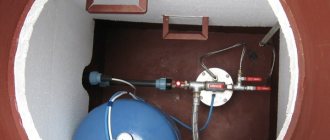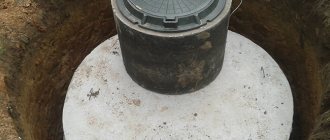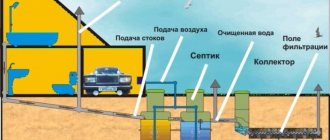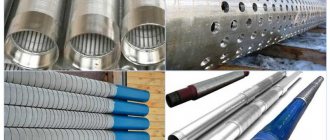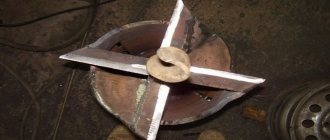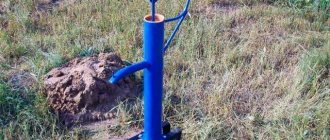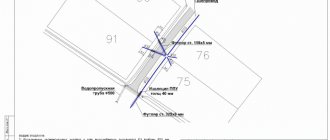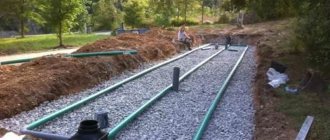02.12.2020
Water
Editorial staff of the “New Place” website
Share
From this article you will learn
:
- Types of wells for a private house
- Selecting a scheme for supplying water to a private house from a well
- Arrangement of a caisson when carrying water from a well
- Laying pipes when carrying water to a private house from a well
How to supply water to a private house from a well so that the system functions without unnecessary hassle and supplies all household members with clean water in sufficient quantities? It all starts with finding water. And it may take several months before the water supply is connected to the house.
Autonomy in water supply is convenient; the cost of laying communications quickly pays off with an uninterrupted supply of clean water under good pressure. Below we describe in detail how to supply water to a private house from a well.
Types of wells for water supply to a private house
Well on sand
Water is pumped from the surface sand layer. The depth of such a well is 20-40 m. A sand well has low productivity (up to 1.5 m3/hour) and is suitable for a small private house. During installation, the water supply system must be equipped with an additional filter to remove sand from the water.
Well for limestone (artesian well)
Water is taken from a deep limestone layer. The well depth reaches 200 m. Thanks to this, it has high productivity (up to 10 m3/hour) and is suitable for water supply to several areas or even a small village. In this case, the water from the limestone soil comes out clean and does not require additional treatment.
Drilling a limestone well is expensive. And you also need to obtain a license to use artesian waters, since they are the property of the state.
The choice of well type depends on the depth of the aquifer. Before constructing a well, test drilling is done to calculate the depth.
Abyssinian well
It is a stainless steel pipe with a tip and a mesh filter. The pipe is driven into the ground to the aquifer, 10-15 meters. A hand pump is connected to the outer end of the pipe. The Abyssinian well is rare, so we will not dwell on it in detail; we are more interested in water supply with a submersible pump.
Main characteristics of the well:
- Well depth.
Equal to the depth at which the aquifer lies. - Static level.
The highest level to which the well is filled. - Dynamic level.
The lowest level to which the pump can pump water. The water does not fall below it. - Well flow rate.
Well productivity, that is, its filling in 1 hour (m3/hour).
The characteristics of the well are indicated in the data sheet; they are necessary for selecting water supply equipment.
Water for autonomous water supply
First of all, it’s worth figuring out what kind of water is suitable for an autonomous water supply device.
If you imagine everything simply and easily, then there are three types of groundwater.
- Verkhovodka . Something that has managed to seep into the soil, but has not yet become a stable aquifer. The weakest water quality. It’s easy to recognize - the water level fluctuates greatly depending on the season. Not suitable for drinking water supply.
- Groundwater . More stable aquifers. The depth ranges from several meters from the surface to several tens. They are mainly used for autonomous water supply.
- Artesian water . The deepest and oldest water carriers. The depth of occurrence can exceed a hundred meters. Water is most often suitable for drinking purposes, but may be too hard and saturated with various minerals.
Water obtained from an autonomous source must undergo a cycle of comprehensive studies at the SES or another organization accredited to conduct water analysis.
Based on the results of the analyzes, conclusions are drawn about the possibility of its use as drinking or technical.
A diagram simulating a hydrogeological section without respect to scale demonstrates the principle of occurrence and distribution of groundwater
The organization that carried out the water analysis can recommend the optimal treatment scheme if the technical option can, after filtration, acquire a drinking category.
Casing pipes for water supply wells
For wells, pipes made of plastic (HDPE, PVC) or metal are used. Plastic pipes are used more often because they are more cost-effective, do not corrode and are easier to install. However, plastic is subject to deformation and the pipe can be compressed by soil, so for wells longer than 60 meters metal pipes are used.
The most common sizes of plastic pipes:
- 113 mm (5 mm wall) is suitable for installing a 3-inch pump together with an adapter.
- 125 mm (7.2 mm wall HDPE and 5 mm PVC) with 3" pump and well adapter or 4" pump with head
Metal pipes for water supply can be welded or threaded. It is better to choose pipes with a welded connection, since the threads become loose over time under soil pressure. Metal pipes are durable, but they are more expensive than plastic ones, are susceptible to corrosion and are more difficult to cut out the inlet hole for the pipe - the bimetallic crown must be cooled with water all the time.
Metal pipe sizes:
- 89mm with 2" pump.
- 114mm with 3" pump.
- 127mm with 3" pump and adapter.
- 133 mm (once such pipes were used everywhere, today they are rare). Suitable for installation is a 4-inch pump, both with a head and in the version with an adapter.
pH corrector systems
The need to adjust the pH level arises when it is necessary to combat corrosion, since water with both low (less than 6) and high (above 8) pH has an increased corrosive effect. On the other hand, to ensure optimal operation of water purification systems, since some types of filter media require a certain pH level for normal operation.
To change the pH level, backfills based on natural calcites are used, which, gradually dissolving, increase the pH. Dosed additions of chemicals to water that lower the pH level are also used.
Methods for organizing water supply from a well
There are two arrangement schemes: with an adapter and a caisson. The most profitable option is to use an adapter with a 3-inch pump. It is installed quickly and simply: below the freezing depth, a special device (adapter) is cut into the casing, through which water enters the supply pipe 32, and then into the house. To arrange this, pipes with a diameter of 113 mm or more are selected for the well.
Fig.3. Installation diagram of water supply from a well using an adapter
Construction of a well with a caisson will cost much more. On our website, the price of a plastic caisson starts from 39,000 rubles. However, in some cases, a well adapter cannot be used on a site, only a caisson. For example, when the water supply needs to be connected not to one building, but to several objects - to a bathhouse, a guest house or a neighboring dacha.
Fig.4. Scheme of well arrangement with caisson
Connecting the hydraulic accumulator and setting up the automation
The hydraulic accumulator is responsible for maintaining constant fluid pressure in the system and also protects the pump from damage. When laying a water supply system in a private house with your own hands from a well, a scheme that includes this element is most often used.
This device plays the role of a storage tank, which operates due to automation. The automation kit is connected using a special bushing equipped with five outputs.
Borehole adapter, installation of water supply from a well without a caisson
The adapter is a small connecting device. It allows you to insert the water supply pipe directly into the casing, without a caisson. Roughly speaking, this is an insertion into the casing below the freezing depth.
Downhole adapter device
Fig.8. Water supply diagram from a well to a house with a well adapter
Advantages of a water supply system with a well adapter:
- Low price. The cost of installing the adapter is 4,500 rubles. For comparison, installation of a caisson with a slab and anchoring costs from 25,000 rubles.
- Installation is less labor-intensive than in the case of a caisson. When installing a caisson, it is necessary to pour a concrete slab, anchor the container, sprinkle the central heating system, install the coupling hermetically and remove the pipe.
- Does not take up space on the site, unlike a caisson.
The adapter is not suitable if you need to supply water to several objects at once (sites or buildings on the same site). In such a situation - only a caisson. Besides:
- The adapter occupies approximately 2.5 cm in the pipe. This must be taken into account when selecting a pump by diameter.
- It is difficult to install. Both parts of the adapter need to be connected correctly on both sides of the casing, this requires skill.
More details in our article: caisson or well adapter.
How to install a borehole adapter:
— A hole is made in the casing pipe with a 40-44 mm bimetallic crown;
— One part of the adapter is screwed onto a metal rod, lowered into the pipe and inserted into the hole.
— The second part of the adapter is inserted into the pipe from the outside and screwed to the first through a sealed rubber ring.
— The third part with the pump connected to it is lowered into the well and inserted into the already secured threaded part of the adapter.
Video: Installing a Downhole Adapter
If you are interested in how to conduct water from a well using an adapter, use our guide to installing a well adapter yourself. Also, if you don’t want to do it yourself, we can install the well using a turnkey adapter.
Choosing pipes for water supply
- Products made of copper are considered to be the best, as they do not rust, have high strength and a long service life. The main disadvantage of copper products is their high cost.
- Metal-plastic products have also gained great popularity. This is due to the fact that such pipes are made of corrosion-resistant aluminum, coated on both sides with a thin polyethylene film. This multi-layer system makes it possible to guarantee high corrosion protection and tear resistance. In addition, the internal polyethylene coating is more resistant to deposits than metal products.
- Polypropylene is characterized by maximum durability and ease of installation. Also, one of the advantages of such products is their low cost and equipment. For example, the price of a simple soldering iron, with which you can lay water pipes throughout the house, rarely exceeds 800–1000 rubles.
Selection of a pump for organizing water supply from a well
For water supply from a well, submersible pumps of small diameter are used - 2-4″ (50.8-101.6 mm). The Zagorod company most often installs Belamos TF centrifugal pumps with a diameter of 3″ (76.2 mm) in water supply systems.
Advantages of Belamos TF-3 well pumps:
- The body is made of high quality stainless steel and brass.
- There is a thermal protection system that turns off the engine if it overheats.
- Special seals allow the pump to be lowered 80 m below the water level.
- The pump operates with solids content up to 180 g/m³.
The water supply pump is selected taking into account the diameter of the casing pipe and the installation method. If a PVC pipe with an internal diameter of 107 mm (OD 125 mm, wall 9 mm) is used, then a 4 inch (101.6 mm) pump can be lowered into it. This option is suitable when installed through a caisson. When installed through a well adapter, it takes up approximately 1 inch (25 mm) inside the pipe and a 4-inch pump cannot be lowered into it, so a pump with a 3-inch diameter is installed.
Other popular pumps for water supply to a summer house or country cottage
Grundfos SQ-3.
Pump housing made of stainless steel. Diameter 3". Can pump water containing sand up to 50 g/cu.m. m. Built-in check valve and dry-running protection relay.
Fig. 10. Well pump Grundfos SQ 3-55
Belamos TF.
The body is made of stainless steel. Diameter 4″ (97 mm). Can pump water from a depth of up to 150 m, depending on the model. There is a built-in check valve. A pump with an optimal price-quality ratio.
Fig. 11. Well pump Belamos TF-25
Pumping stations for wells
In addition to submersible pumps, we install surface pumps (pumping stations) for wells. But there are nuances:
- The pumping station lifts water from a depth of no more than 8 meters.
- The pumping station is not used with a drain valve. When installing a caisson, this is not a problem; it can have a separate tap for draining water.
- To start the pumping station, there must be water in the system. It is filled through the station.
- The station creates noise during operation. It is better to install it in a dry, warm basement or in a separate technical room or in a caisson.
Important! Do not use the pumping station if the dynamic water level drops below 8 m. The station will not lift water from such a depth.
The Zagorod company provides water supply with Belamos and Grundfos MQ pumping stations.
Belamos Stations
already come assembled with a hydraulic tank and pressure switch. If the station overheats, it automatically turns off.
Grundfos MQ pumping stations
are equipped with a check valve, a pressure switch and a dry-running protection relay. They also have a built-in hydraulic tank, but it is small, so a hydraulic tank of the required volume is usually installed with the station.
Practical tips for installing piping around the house
For year-round operation of a water supply system from a well, you should use the following tips:
- The ideal home plumbing is done in such a way as to prevent pipes from passing through the walls of the premises. But, since the lining leads to a significant increase in the cost of the system, the pipeline is laid inside the walls, but using a protective metal cup, which protects them from deformation caused by shrinkage of the building.
- It is necessary to ensure a minimum gap of at least 20–25 mm between parallel pipes and building structures. This will greatly simplify future repairs. If you do not want to leave the wiring in plain sight, you should hide it in pre-prepared grooves, insulating them at the same time.
- If the water supply system is equipped with drain taps, they should be installed at the lowest points of the system so that water can flow through the drain tap by gravity.
- The easiest method for attaching pipes to walls is using plastic crabs. The distance between them should not exceed two meters with a pipe diameter of 16–20 mm; with a larger size, the distance between the fasteners should be smaller. A well-organized and executed water supply system has the following features:
- Has a minimum number of welded joints. This makes it possible to significantly increase the reliability of the units, while a less powerful and therefore cheaper pump can be used to pump water.
- All joints are made in full accordance with the installation diagram for this particular type of pipeline (series or parallel connection).
- Shut-off valves are installed in all important sections of the water supply system.
- Keep a minimum number of unreliable hose connections - it is advisable to connect even the flush tank on the toilet with a plastic tube rather than a hose.
Automation for water supply wells
Downhole automation is conventionally divided into three generations:
First generation.
The simplest automation. Consists of a hydraulic accumulator, pressure switch and dry running relay (optional).
Second generation.
Control unit and electronic sensors. A hydraulic accumulator is not required.
Third generation.
Programmable systems allow you to control the pump up to adjusting the voltage supply to the motor.
Read more about automation systems for borehole pumps in our article automation for pumping equipment.
The Zagorod company installs first generation automation. It is simple, but inexpensive and reliable. The devices are mounted through a five-pin fitting (five-pin). The following is connected to the connector terminals:
- Pump.
- Internal water supply pipe.
- Pressure gauge.
- Hydraulic accumulator.
- Pressure switch.
Fig. 13. Scheme of water supply from a well with a hydraulic accumulator
Question! Is it possible to do without a hydraulic accumulator in a water supply system?
Yes, you can. To do this, it is necessary to install the appropriate automation (unlike well pumps, well pumps do not have built-in automation). However, comfortable conditions - with a standard of 20-30 starts - can only be achieved by using a hydraulic accumulator. Without a hydraulic tank, the pump will turn on every time the tap is opened, and the automation will not protect against water hammer.
The pressure switch turns the pump on or off when the pressure changes. At the bottom of the relay there is a metal membrane. When the taps are closed, the pressure increases, the membrane bends upward and moves the spring to a given range. When displaced, the circuit opens and the pump turns off. When the tap is opened and the pressure drops, the membrane returns to its original position. The spring opens and closes the circuit. The pump turns on. If there is water in the hydraulic tank, it enters the pipes and compensates for the pressure drop. The pump does not turn on, its working life is saved.
Do-it-yourself connection of a pressure switch in a water supply system from a well
Fig. 16. Electrical diagram for connecting the pump automation
Draining water from a well for the winter
To drain water for the winter, a drain valve is installed in a caisson. If an adapter is installed, an automatic drain valve is installed on the pipe in the well. Important: when using a surface pump (pumping station), the drain valve is not used.
Fig. 17. Operating principle of the drain valve
Watering tap
You can also remove the watering tap. When piping through an adapter, the tap is removed from the house. If a caisson is installed, then the output is made from the caisson. In summer, the tap is used for watering, in winter - for setting up a skating rink or slide on the playground.
Fig. 18. Removing the watering tap from the caisson
Fig. 19. Removing the watering tap from the house
Softening systems
An extensive class of devices designed to reduce water hardness. Thanks to the use of special backfills, systems of this type can have a complex effect and are also capable of removing certain amounts of iron, manganese, nitrates, nitrites, sulfates, heavy metal salts, and organic compounds from water.
Activated carbon has long been used in water treatment to improve the organoleptic properties of water (eliminate foreign taste, odor, color). Due to its high adsorption capacity, activated carbon effectively absorbs residual chlorine, dissolved gases, and organic compounds. However, since accumulating organic matter is difficult to remove from coal during backwashing, a burst discharge of contaminants into the outlet line is possible. To prevent this phenomenon, the activated carbon backfill requires periodic replacement. Currently, to increase the service life, activated carbon from coconut shells is used, the adsorption capacity of which is 4 times higher than that of carbon produced by traditional methods (for example, from birch wood). To combat biological growth, special coals with bacteriostatic additives are also used, as well as backwash systems.
House water supply unit
Entry is made in a technical room or bathroom through a 1” tee and a “1” ½ fitting. Then screw in the gland and clamp the cable. The seal is necessary to ensure tightness.
The input kit is usually three meters (the distance from the tee to the freezing point). In most cases, this is enough even if the house is on stilts.
Water treatment for a private home
Groundwater may contain excess chlorine, iron, manganese, calcium and magnesium. Special filters have been developed to purify water.
A water treatment system is a set of filters with different functions:
- Aeration filters remove iron. It oxidizes and precipitates;
- In filters for mechanical cleaning, large suspensions, sand, and rust particles are deposited;
- Activated carbon filters retain chlorine;
- In ion exchange filters, water is softened;
- pH filters even out the acid-base balance.
Before selecting equipment, you need to determine the chemical composition of the water, that is, find out what it needs to be purified from. It is recommended to immediately do a water analysis after pumping the well. If you buy a water treatment system from our company, we can take the water for analysis. It takes several days. After this, we will select equipment for water treatment. You can do the wiring of the filters according to the diagram yourself; it’s not difficult. We recommend ordering commissioning of the system from us.
Laying water pipes around the house
Collector wiring
They install common collectors (combs) for cold and hot water, from which pipes are drawn to each plumbing fixture. Thanks to this, you can use the bathtub, sink and kitchen sink at the same time, without any pressure surges.
Important! There are often errors in diagrams from the Internet. For example, in this diagram, the oblique filter is installed with the mesh facing up. This cannot be done: dirt will not get into the filter, and the pipe will become clogged over time. This must be taken into account when installing yourself.
When to use:
- If there are many water points in the house, you can shut off the water for each point separately.
- If pipes need to be hidden.
This wiring is most popular in cottages from 100 sq.m. made of aerated concrete or wooden frame. In large cottages it is easier to allocate space for collectors, and in the walls and floors of frame and aerated concrete houses it is easy to hide large quantities of pipes.
For collector wiring, pipes made of cross-linked polyethylene or metal-plastic 16 mm are used. Our standard option is a hidden collector distribution with metal-plastic pipes.
Tee wiring
Tee bends are installed on the pipes to the water collection points.
Applies when:
- There is little plumbing in the house.
- If the pipes cannot be laid hidden.
This wiring is cheaper and the system takes up little space. Ideal for houses and cottages with a small number of residents. The peculiarity of this wiring is that if you turn on the water at one water intake point, the pressure at subsequent ones drops.
For tee distribution of water supply, 20 mm polypropylene pipes are used. If there are more than 3 water supply points on one branch, then it is preferable to take a 25 mm PP pipe.
Main stages
Today’s most popular scheme for organizing water supply in a private home takes into account the use of a hydraulic accumulator. Its implementation is divided into three necessary stages:
- drilling a well (if there is a need for it);
- installation of equipment;
- distribution of pipeline communications.
Each stage requires careful consideration. Equipment installation and pipe routing have many nuances that are also worth considering. Before starting work, it is recommended to study photo and video materials on this topic, as well as visit specialized forums.
Hot water supply from a well to the house
To heat water for autonomous water supply, an electric heating boiler (water heater) is used. Such heaters have a storage tank of 50-200 liters. When selecting a water heater, pay attention to the volume of the tank and the power of the unit. The higher the power, the faster the water heats up. Standard power is 1.5-2 kW. With it, 100 liters will heat up in 3 hours.
When installing a boiler, it is imperative to provide for water drainage; for this, a drain valve is installed at the cold water inlet.
If a gas main is laid to the cottage or dacha, then it is beneficial to purchase a gas water heater for hot water supply.
You can also make a water supply from a heating boiler. For example, from a double-circuit gas boiler. But in this option there is a limitation of up to 12 l/s, which is enough if there are up to 3 points in the house where it is supplied. If you need more, you need to use an indirect heating boiler; in this method, you can circulate hot water
Finding water for a well on the site
About a quarter of users complain that drilling did not lead to the desired result. That is, after the drill went deep to a depth of 30 meters, water suitable for consumption in terms of quality or quantity did not appear.
In order not to join the ranks of those who have thrown money away, you need to approach the search for water responsibly. After all, in order to reduce drilling costs, it is necessary that the aquifer lies as close to the surface as possible.
Ways to determine the presence of water:
- Biological signs. Plants can show how deep the water lies. So, for example, cattail grows where water is no deeper than 1 m from the surface, wormwood - up to 7 m, yellow alfalfa up to 15 m;
- dew. The closer the water is to the surface, the more dew will be on the plants in that area;
- silica gel. It needs to be wrapped in cloth and buried to a depth of 1 m. After a day, see how much moisture it has absorbed. The more, the closer the water;
- dowsing A frame made of vines and wire also gives very accurate results and is the most popular way among users to determine the depth of an aquifer;
- test drilling. Gives 100% results, but requires high costs.
Do-it-yourself water supply at home from a well
What will you need for self-installation?
Hot air gun.
If water supply is installed from a well or from a well with a caisson, then the pump is connected through a heat-shrinkable sleeve. To make the clutch seat, it is heated with a hairdryer.
T-shaped installation key.
It is screwed into the adapter with the pump connected. You can buy it at a hardware store for 1000 rubles. or make it yourself from metal or polypropylene pipes.
Mounting key for lowering the adapter with the pump into the well.
You can make it yourself from metal pipes.
L-shaped mounting wrench.
You can also make it yourself from metal pipes. The end must have an external thread.
Bimetallic crown with a diameter of 44 mm.
For drilling a hole when installing a downhole adapter.
Soldering iron (“iron”).
Needed for soldering polypropylene pipes. Average price – 3000 rub.
Apparatus for welding polypropylene pipes.
Press jaws
. Connections through press fittings are one-time, permanent, so they can be hidden under the screed. For installation, special presses are used, manual or electric. Manual press pliers cost about 6,000 rubles, electric ones cost about 50,000 thousand rubles. This must be kept in mind if you plan to install it yourself.
Fitting.
For installation of metal-plastic pipes, crimp or press fittings are used. Compression fittings are tightened with a compression nut. The nut must be tightened from time to time, so the pipeline with such fittings must be visible.
Adjustable wrench.
Required for installation of fittings.
"Swede".
With its help, pipes and other elements without edges are captured.
Sealant.
To seal threaded connections, it is recommended to use plumber's flax and paste (putty), for example, Unipak. Fum tape and other similar materials are highly discouraged.
Caisson
There are different options for constructing a caisson: a metal welded box or large-diameter pipe, concrete well rings, brickwork, plastic.
Monolithic concrete on formwork is the most reliable, although complex. It allows you to make a structure of any configuration and depth. You can even install brackets for lowering and lifting into the walls, provide space for a storage tank and freely place all the necessary equipment.
When arranging a caisson, it is necessary not only to take care of reliable protection against precipitation getting inside, it is necessary to waterproof and insulate the walls. The hole can be dug with a margin around the perimeter so that the remaining gap can be filled with a mixture of sand and crushed stone - this will protect the structure, both as drainage and as a means of “squeezing out” in heaving soils.

